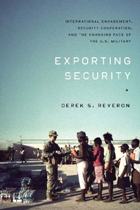Exporting Security: International Engagement, Security Cooperation, and the Changing Face of the U.S. Military

During the past decade, the U.S. military has shifted its strategic thinking to refocus the ‘situational awareness from the state level to the sub-state and even group levels’ and build military-civilian partnership to fill the roles ‘normally reserved for civilian agencies or private actors’. Exporting Security by Derek S. Reveron provides timely alternative arguments on the tensions and interconnections between the U.S. military and civilian sector in security governance and highlights military-civilian partnership as a proper solution which ‘needs partners from across the government, allies and private organisations’. It covers a set of non-military missions (e.g. humanitarian assistance, medicine, civil engineering and security assistance).
This thought-provoking book features eight chapters which form three thematic sections. While section one explores the strategic rationale behind the U.S. military’s establishing military-civilian partnership, the following section focuses on how the academia and policy makers are divided on the expanding role of the U.S. military in security governance. For example, the traditionalists believe that the U.S. military’s expanded role might be ‘ill suited for major combat’. In contrast, Reveron argues that the strategic shift from military confrontation to military-civilian cooperation would not diminish the U.S. war-fighting capabilities or lead to militarisation of foreign policy.
The final section explores the characteristics of military-civilian partnership adopted by the U.S. military. First, the partnership incorporates personnel from other government agencies and private organisations into the U.S. military command structures. The most significant case is that of the appointments of senior non-military officers into the highest level of U.S. military commands such as the U.S. Africa Command and U.S. Southern Command. Second, the partnership has increased the proportion of the civilian agencies in the military-civilian partnership. For instance, after the withdrawal of the U.S. military from Iraq and Afghanistan, the peacekeeping training has been shifted to ‘government contractors’ to a large extent.
It is worth noting that the military-civilian partnership has its own limitations. First, the military-civilian partnership is suitable to combat low-intensity conflicts. In other words, it remains to be discussed whether this partnership is available in worst-hit areas of armed conflicts. Moreover, in a resource-constrained environment, the partnership cannot ‘protect all partners from aggression’ because the U.S. military is short of personnel and strategic weapons. Also, the partnership is not applicable to the states dominated by military elites or countries with a colonial heritage, especially the ones that ‘have difficulty seeing foreign military forces in non-imperial ways’.
In short, Exporting Security is an excellent reading for scholars, students and policy makers interested in U.S. military strategy and military-civilian cooperation.
Derek S. Reveron, Exporting Security: International Engagement, Security Cooperation, and the Changing Face of the U.S. Military. Washington, DC: Georgetown University Press, 2010.
Reviewed by Dr Kai Chen, College of Public Administration, Zhejiang University, China





